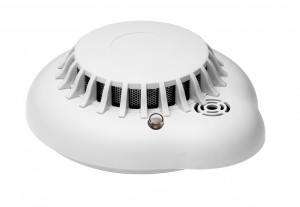While we all try to do what we can to prevent residential fires, the easiest, most effective action we can take is to install smoke detectors in every room of our home. A properly installed and maintained smoke detector is on alert 24 hours a day, whether you are awake or asleep, scanning for fire or smoke. The best smoke detectors are reliable, durable and easy to test and maintain. Read below for our smoke detector tips.
Ionization Smoke Detectors contain a very small amount of americium-241 within its ionization chamber. They create an electrical current between two metal plates which sounds an alarm when disrupted by smoke entering the chamber. Ionization Smoke Alarms can quickly detect the small amounts of smoke produced by fast flaming fires, such as cooking fires or fires fueled by paper or flammable liquids. This type of smoke detector which is commonly used in kitchens is prone to nuisance tripping and may start chirping when the cake is in the oven too long or such things as that.

Photoelectric Smoke Detectors contain a light source in a light sensitive electric sensor which is positioned at 90 degree angles to one another. Normally light from the light source shoots straight across and misses the light sensor. When smoke enters the chamber it scatters the light which then hits the sensor and triggers the alarm. Photoelectric sensors typically respond faster to a fire in its early smoldering stages, before the source of the fire bursts into flames. These detectors are most sensitive to the large combustion particles that emanate during slow, smoldering fires which often occur at night when people are asleep.

Dual Sensor Smoke Detectors include both Ionization and Photoelectric sensors so they should adequately alert homeowners to a smoldering or a fire with active flames. However, there are no industry standards for setting the individual sensor sensitivity in dual sensor alarms. This means that a dual function alarm could have a non-functional ionization sensor, but as long as the photoelectric sensor works it still meets the national standards developed by the Underwriters Laboratories (UL).

Which one should you buy? The International Association of Firefighters (IAFF), the largest firefighter’s union in the US and Canada has adopted an official position recommending only Photoelectric Smoke Detectors and has stated that dual sensor alarms are no longer acceptable. The technology used in Ionization Smoke Detectors creates a delayed warning in smoldering fires which can lead to loss of life. Photoelectric Smoke Alarms are more effective at warning of smoke from smoldering fires and are less susceptible of nuisance alarms. The IAFF recommends replacing all ionization, dual sensor and unknown alarms with photoelectric smoke alarms.
What type of alarm do you have? Most residences have smoke detectors installed before their inhabitants move in. To find out whether you have ionization, photoelectric or dual sensor alarms take the smoke alarm down from the ceiling or wall and inspect the back. You may want to find professional help to do this. Every ionization alarm will have reference to the trace material americium-241 labeled on the back or the label will give reference to the fact that the alarm is photoelectric or both if it is a dual alarm.
When purchasing keep in mind the smoke alarm should be easy to install, capable of being tested, has a battery or battery backup, has a silence button which allows you to deactivate if a false alarm is given, has a 5 to 10 year warranty, can be purchased in a package of 4 to 6 alarms and can be if the model is a hardwired unit interconnected with other units. Also, check with your local and state authorities to learn about any specific requirements. If you are replacing existing detectors in the home they must be replaced with the same types and better yet all smoke detectors should be replaced at the same time.
